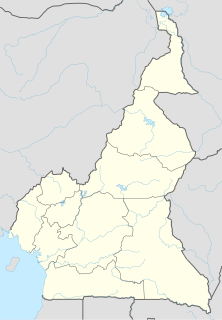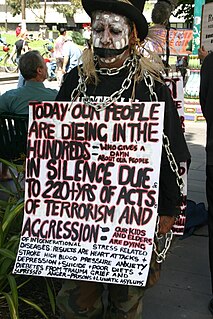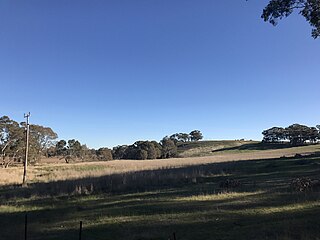
Loddon is a small market town and electoral ward about 12 miles (19 km) southeast of Norwich on the River Chet, a tributary of the River Yare within The Broads in Norfolk, England. The name "Loddon" is thought to mean muddy river in Celtic in reference to the Chet.

The Loddon River, an inland river of the north–central catchment, part of the Murray-Darling basin, is located in the lower Riverina bioregion and Central Highlands and Loddon Mallee regions of the Australian state of Victoria. The headwaters of the Loddon River rise on the northern slopes of the Great Dividing Range east of Daylesford and descend to flow north into the Little Murray River, near Swan Hill. The river is impounded by the Cairn Curran and Laanecoorie reservoirs.

Sangmélima is a town on the Lobo River, and also the chief town of Lobo division, in the South Province, Republic of Cameroon, Africa. The language spoken there is Bulu. French, is also spoken as it is one of the official languages in Cameroon.

The Taungurong people, also known as the Daung Wurrung, were thirteen clans who spoke the Daungwurrung language and were part of the Kulin alliance of indigenous Australians. They lived to the north of and were closely associated with the Woiwurrung speaking Wurundjeri people. Their territory was to the north of the Great Dividing Range in the watersheds of the Broken, Delatite, Coliban, Goulburn and Campaspe Rivers. They were also known by white settlers as the Devil's River Tribe or Goulburn River Tribe.

Campbells Creek is a town in Victoria, Australia.

Djadjawurrung or Dja Dja Wurrung, also known as the Jaara or Jajowrong people and Loddon River tribe, is a native Aboriginal tribe which occupied the watersheds of the Loddon and Avoca rivers in the Bendigo region of central Victoria, Australia. They were part of the Kulin alliance of tribes. There were 16 clans, which adhered to a patrilineal system. Like other Kulin peoples, there were two moieties: Bunjil the eagle and Waa the crow.

Muckleford is a small regional area in central Victoria, Australia. The area, also known as Wattle Flat, lies along the Muckleford Creek, a minor tributary of the Loddon River approximately 127 kilometres northwest of the Melbourne City Centre and within the jurisdiction of the Mount Alexander Shire council. The nearest sizeable town is Castlemaine, approximately 7km to the east. The original township is named after the English hamlet of the same name in Dorset.
Munangabum was an influential clan head of the Liarga balug and Spiritual Leader or neyerneyemeet of the Dja Dja Wurrung people in central Victoria, Australia.
The Blood Hole massacre occurred in what is now the Australian state of Victoria at Middle Creek, 6 – 7 miles from Glengower Station between Clunes and Newstead at the end of 1839 or early 1840, killing an unknown number of Aborigines from the Grampians district who were on their way home after trading goods for green stone axe blanks that they obtained near what is now Lancefield.
Campaspe Plains massacre, occurred in 1839 in Central Victoria, Australia as a reprisal raid against Aboriginal resistance to the invasion and occupation of the Dja Dja Wurrung and Daung Wurrung lands. Charles Hutton took over the Campaspe run, located near the border of Dja Dja Wurrung and Daung Wurrung, in 1838 following sporadic confrontations.

Edward Stone Parker (1802–1865) was a Methodist preacher and assistant Protector of Aborigines in the Aboriginal Protectorate established in the Port Phillip District of colonial New South Wales under George Augustus Robinson in 1838. He established and administered the Franklinford Aboriginal Protectorate Station in the territory of the Dja Dja Wurrung people from January 1841 to the end of 1848.

Franklinford is a small community in the Central Highlands of Victoria, Australia, located in the Shire of Hepburn. It was the site chosen by Edward Stone Parker to build the Loddon Aboriginal Protectorate station at Franklinford in January 1841 which was an important focus of the Dja Dja Wurrung people from 1841 until they were forcibly resettled in 1864. It is located on the Midland Highway.
Thomas Dunolly (1856–1923) was an early Indigenous Australian rights activist. He was a member of the Dja Dja Wurrung people. The surname Dunolly is the name of the township where he was born.

The Kulin languages are a group of closely related languages of the Kulin people, part of the Kulinic branch of Pama–Nyungan.

Djadjawurrung is one of the extinct Indigenous Australian languages spoken by the Jaara also known as Dja Dja Wurrung people of the Kulin Nation of Central Victoria. Djadjawurrung was spoken by 16 clans around Murchison, the central highlands region, east to Woodend, west to the Pyrenees, north to Boort and south to the Great Dividing Range.

John Hunter Kerr (1820-1874) was a Scottish-born grazier, amateur photographer and collector of Indigenous artefacts in Victoria, Australia, during the mid-nineteenth century. He was the fourth son of Captain A R. Kerr, R.N., C B, and brother of Vice-Admiral R. Kerr.
Djadja & Dinaz is a French hip hop duo from Meaux and made up of Gianni Bellou (Djadja) and Azzedine Hedhli (Dinaz).

Junortoun is a suburb of Bendigo, Victoria, Australia. The suburb is located 6 kilometres (3.7 mi) east of the Bendigo city centre along the McIvor Highway. At the 2016 census, Junortoun had a population of approximately 3,200.

"Djadja" is a song by Malian singer Aya Nakamura. Released in 2018, it reached number one in France, the Netherlands and Romania.











